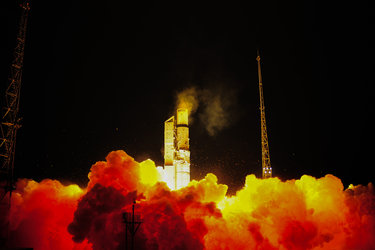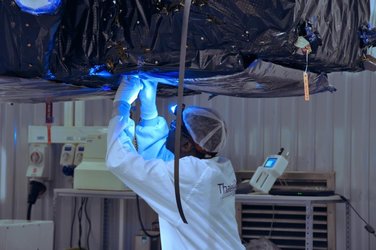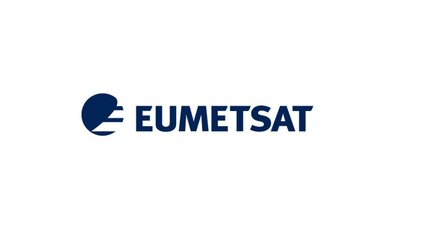Susanne Mecklenburg: Mission Manager
In an interview, Sentinel-3 Mission Manager Susanne Mecklenburg explains how Sentinel-3 data will be processed in collaboration with Eumetsat, and her role in the exploitation in Sentinel-3 data products.

Susanne, a German national, has been working at ESA’s ESRIN Earth Observation Centre in Frascati, Italy, since 2007 as the SMOS Mission Manager. Susanne has been responsible for the smooth running of the SMOS – Soil Moisture and Ocean Salinity – mission and the exploitation of the mission’s data. She takes care of all technical aspects of the mission operations and maintains close links with the user community from around the world. After six years in orbit, the focus of her work with SMOS has shifted from proofing the mission concept to promoting SMOS data in an operational context and thinking about potential follow-on missions.
In 2011 Susanne also became the Mission Manager for Sentinel-3. The focus of her work is on maintaining close links with the operational users of the mission’s data products, namely the Copernicus Core Services. She works closely with her colleagues from Eumetsat, with whom ESA jointly manages the Sentinel-3 mission, and the European Commission.
Before joining ESA, Susanne worked in the UK at the British National Space Centre and the Centre for Ecology and Hydrology. Susanne received a master’s degree in hydrology from the Technical University of Dresden, Germany and a PhD in atmospheric science from the Swiss Institute of Technology, Zurich, Switzerland, where she also lectured.
ESA: What will be your main role as the Sentinel-3 Mission Manager?
Susanne Mecklenburg
As a Mission Manager, I am responsible for the end-to-end mission performance. I rely of course on the expertise being available in the Sentinel-3 operations team, be it for the space or the ground segment. This comprises a rather specialised and diverse team. But most of all I need to ensure that the user needs are met. This regards mainly the operational users from the Copernicus services but also other scientific and commercial users. Hence it is very important to collate feedback from key Copernicus users, Member States and the broader science community, for consideration in the evolution of the mission.
Sentinel-3 is quite distinct from Sentinel-1 or -2 in that we share the mission operations with Eumetsat. The development of Sentinel-3, including the launch, has been delegated to ESA. In operations though, ESA and Eumetsat will share the responsibility for the smooth running of the mission. Once the commissioning phase – the first five months in orbit when the satellite’s functionality is tested – has been successfully completed, ESA passes the operations of the satellite to Eumetsat. ESA will continue to monitor the health of the satellite, including platform and instruments. ESA will be responsible for the operations of the Sentinel-3 ground segment for land-related products as well as the continuous improvement of the mission’s data products through research and development activities. Eumetsat will take care of the providing the marine products.
Practically speaking, I work closely with my colleagues in Eumetsat to ensure the smooth running of the mission on a day-to-day basis. In particular I work with my colleagues in ESOC and Eumetsat to ensure smooth spacecraft and payload operations. The Post Launch Support Manager in ESTEC and the industrial teams supporting him ensure the long-term health of the satellite and will lead investigations in case we experience anomalies. Together with the Operations Manager and the Data Quality Managers, I will ensure that Sentinel-3 data products are of adequate quality and get to users in a timely fashion.
ESA: Once Sentinel-3 has completed its commissioning phase, how will data be delivered and processed?
Susanne Mecklenburg
In general, all Sentinel-3 instruments systematically acquire data, so there will be no scheduling of instrument operations in orbit like for Sentinel-1 or -2, for example. All facilities supporting the Sentinel-3 operations are in place, including data processing – depending on the product – between three hours from sensing to non-time critical for more consolidated data and regular checks for the quality of the data. The data dissemination from ESA will follow the same routes as for Sentinel-1A and -2A through the various Data Hubs, which have been successfully providing more than 18 000 users with Sentinel data since October 2014. It follows the full, open and free data policy as laid out in the EU regulation on Copernicus and makes all Sentinels core products accessible to all users online.
The first five months of the mission will be dedicated to testing that the platform and the instruments on Sentinel-3 are working well and are up for routine operations. During this period, some reference sets of core products will be released to expert users for a first feedback on the data quality. At the end of these initial five months we intend to release operationally qualified level 1 Sentinel-3 core data products, and also a pre-view for some of the geophysical level 2 products.
ESA: What will be some of the main uses of the data, and who will be the users?
Susanne Mecklenburg
Sentinel-3 will serve a large variety of application areas thanks to the fact that it hosts three very unique instruments. The primary customers for the data are of course the Copernicus Services, in particular the Land and Marine Environment Monitoring Services. Just to give some examples, over land applications comprise using land surface temperatures for weather forecasting and climate research, using vegetation relevant data for agricultural applications, including food security and crop yield management, or using altimetry data for fresh water resources management (river and lake water levels). The Atmospheric Monitoring Service will use the newly introduced Aerosol Optical Depths product and the Emergency Monitoring Service will make use of the fire radiative power data.
Sentinel-3 is of course also the core operational mission for the Copernicus Marine Environment Monitoring Services (CMEMS) having estimated that the Sentinel-3 data will contribute to about 70% of all CMEMS user products.
Beyond the Copernicus services there is a multitude of scientific users, exploiting for example the fact that all of the instruments on board Sentinel-3 provide continuity to previously flown instruments. Hence they extend already existing data series, for example of sea surface temperature, sea level or the radiation budget, important parameters being used as Essential Climate Variables in monitoring changes in Earth’s climate.
ESA: What are you most looking forward to with this mission?
Susanne Mecklenburg
One of the main interesting points for me in Sentinel-3 is its variety in the data it produces. Thanks to the fact that the mission comprises three very distinct instruments, there will be a multitude of applications and opportunities to use these data in a complementary fashion. This also means that I will be working with a large variety of different user communities. It is a truly multi-disciplinary mission. Sentinel-3 data will also have a real impact on our everyday lives, being used in services that are already up and running and providing data or advice to citizens. That makes Sentinel-3 a very tangible mission for me.
Editor's note:
This is one in a series of interviews with a few of the key people that are involved in the Sentinel-3 mission. Please check back as further interviews will be added to over the coming weeks.









